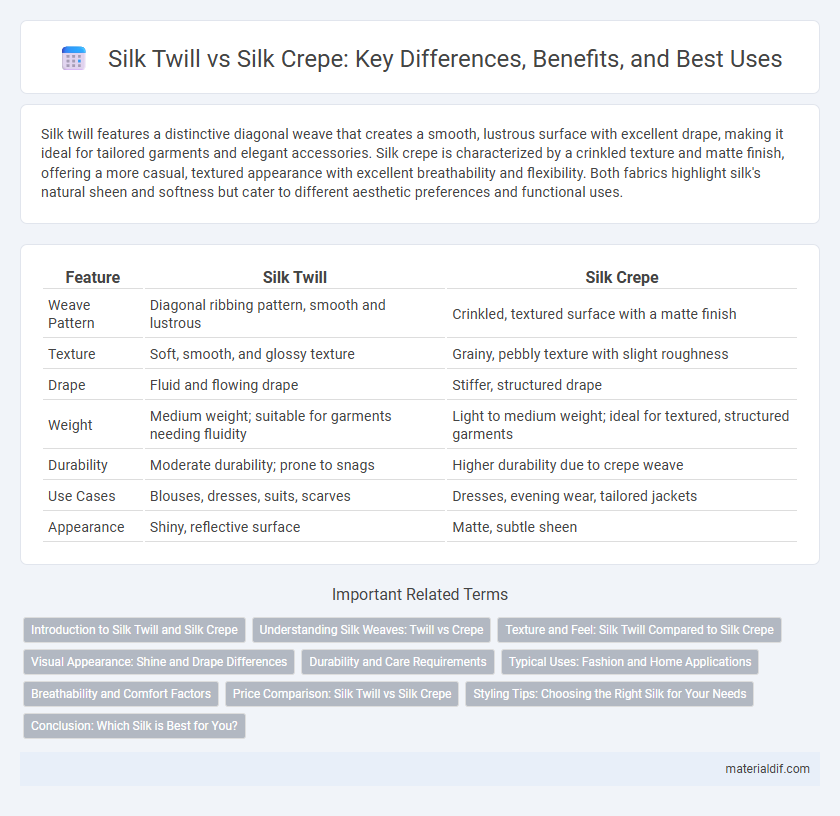Silk twill features a distinctive diagonal weave that creates a smooth, lustrous surface with excellent drape, making it ideal for tailored garments and elegant accessories. Silk crepe is characterized by a crinkled texture and matte finish, offering a more casual, textured appearance with excellent breathability and flexibility. Both fabrics highlight silk's natural sheen and softness but cater to different aesthetic preferences and functional uses.
Table of Comparison
| Feature | Silk Twill | Silk Crepe |
|---|---|---|
| Weave Pattern | Diagonal ribbing pattern, smooth and lustrous | Crinkled, textured surface with a matte finish |
| Texture | Soft, smooth, and glossy texture | Grainy, pebbly texture with slight roughness |
| Drape | Fluid and flowing drape | Stiffer, structured drape |
| Weight | Medium weight; suitable for garments needing fluidity | Light to medium weight; ideal for textured, structured garments |
| Durability | Moderate durability; prone to snags | Higher durability due to crepe weave |
| Use Cases | Blouses, dresses, suits, scarves | Dresses, evening wear, tailored jackets |
| Appearance | Shiny, reflective surface | Matte, subtle sheen |
Introduction to Silk Twill and Silk Crepe
Silk twill features a distinctive diagonal weave that offers a smooth surface with a slight sheen, making it highly durable and drapable for garments and accessories. Silk crepe, characterized by its crinkled texture and matte finish, provides a lightweight and breathable fabric ideal for flowing dresses and blouses. Both fabrics highlight silk's natural luster and softness while catering to different stylistic and functional needs in textile design.
Understanding Silk Weaves: Twill vs Crepe
Silk twill features a distinctive diagonal weave that enhances durability and imparts a smooth, lustrous surface ideal for tailored garments and upholstery. Silk crepe is characterized by a crinkled, textured finish created through tightly twisted yarns, offering a matte appearance with excellent drape suited for flowing dresses and blouses. Understanding these weave structures helps in selecting silk fabric based on desired texture, sheen, and application.
Texture and Feel: Silk Twill Compared to Silk Crepe
Silk twill features a distinct diagonal weave that creates a smooth, lustrous surface with a soft, fluid drape, making it ideal for garments requiring a polished, structured appearance. Silk crepe, characterized by its tightly twisted yarns, offers a textured, slightly grainy feel with excellent elasticity and a matte finish, providing a more casual and breathable experience. The tactile difference lies in twill's sleekness versus crepe's textured softness, influencing choices in luxury fashion and upholstery.
Visual Appearance: Shine and Drape Differences
Silk twill exhibits a distinct diagonal weave pattern that enhances its natural sheen, resulting in a glossy surface and smooth drape ideal for structured garments. In contrast, silk crepe features a crinkled, matte texture with a looser, flowing drape that creates a softer, more muted visual effect. These differences in weave and finish directly influence the choice between silk twill's polished elegance and silk crepe's understated sophistication in fashion and textile design.
Durability and Care Requirements
Silk twill is known for its durability due to its tightly woven diagonal pattern, making it more resistant to wear and tear compared to silk crepe, which has a looser weave and delicate texture. Silk crepe requires gentler care methods such as hand washing or dry cleaning to maintain its texture and prevent damage, while silk twill is better suited for machine washing on a gentle cycle with mild detergent. Choosing silk twill offers a combination of resilience and easier maintenance, ideal for everyday use and garments needing frequent laundering.
Typical Uses: Fashion and Home Applications
Silk twill is favored for fashion applications such as tailored suits, blouses, and scarves due to its smooth, lustrous finish and diagonal weave that enhances durability and drape. In home decor, silk twill is commonly used for luxurious upholstery, cushion covers, and drapery that require both elegance and resilience. Silk crepe, characterized by its crinkled texture and matte appearance, is typically used in flowing dresses, evening gowns, and scarves, while in interiors it is chosen for textured curtains and delicate pillow covers that add a soft, tactile dimension.
Breathability and Comfort Factors
Silk twill features a tight, diagonal weave that offers moderate breathability while maintaining a smooth and durable texture ideal for structured garments. In comparison, silk crepe's crinkled, textured weave enhances airflow and moisture-wicking properties, making it significantly more breathable and comfortable for warm climates. The natural protein fibers in both fabrics provide softness and temperature regulation, but silk crepe excels in lightweight comfort due to its looser weave and higher breathability levels.
Price Comparison: Silk Twill vs Silk Crepe
Silk twill generally commands a higher price than silk crepe due to its more complex weaving process that creates a distinct diagonal pattern and smoother texture. While silk crepe is prized for its lightweight, matte finish and slight crinkle effect, its production often costs less, making it more budget-friendly. The price difference between silk twill and silk crepe reflects variations in production intricacy, fabric weight, and end-use applications in luxury fashion and home textiles.
Styling Tips: Choosing the Right Silk for Your Needs
Silk twill offers a smooth texture with a subtle sheen, making it ideal for structured garments like blazers and skirts that benefit from a polished, elegant look. Silk crepe features a crinkled, matte finish with excellent drape, perfect for flowing dresses and blouses that emphasize softness and movement. Selecting silk twill or crepe depends on the desired silhouette and occasion, balancing formality with comfort and style preferences.
Conclusion: Which Silk is Best for You?
Silk twill offers a smooth, lustrous finish and excellent drape, making it ideal for structured garments and formalwear. Silk crepe features a textured surface with a slightly crinkled appearance, providing a lightweight, breathable option perfect for flowy dresses and delicate blouses. Your choice depends on whether you prioritize elegance and sheen with silk twill or a soft, matte texture and airy feel with silk crepe.
Silk twill vs Silk crepe Infographic

 materialdif.com
materialdif.com